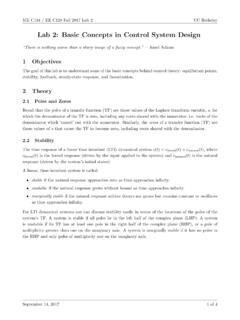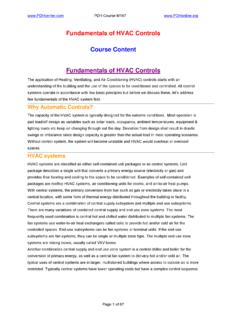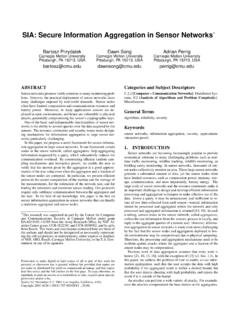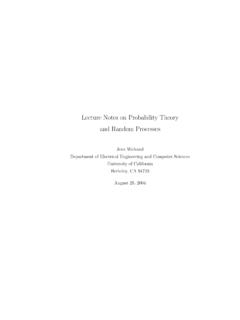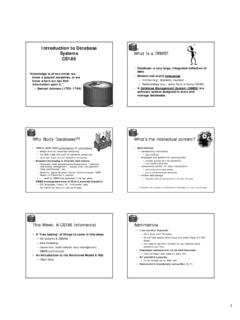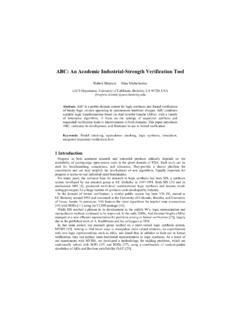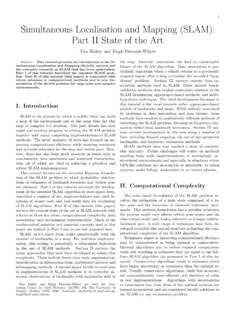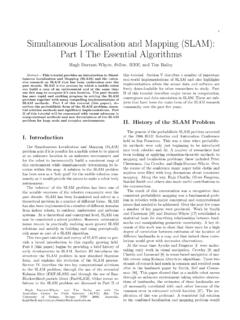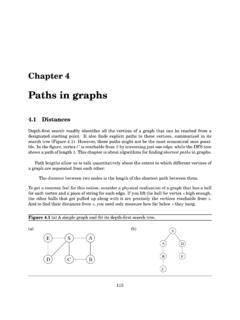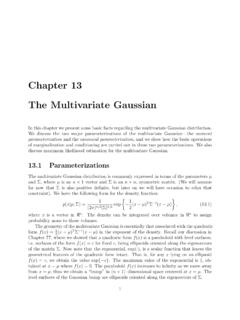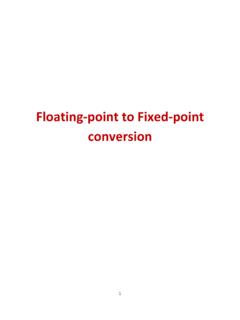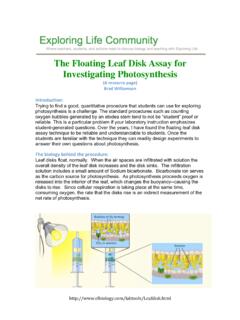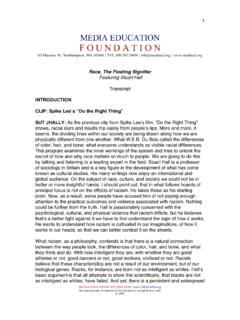Transcription of IEEE Standard 754 for Binary Floating-Point Arithmetic
1 Work in Progress: Lecture Notes on the Status of ieee 754 October 1, 1997 3:36 am Lecture Notes on the Status of ieee Standard 754 for Binary Floating-Point Arithmetic Prof. W. Kahan Elect. Eng. & Computer Science University of California Berkeley CA 94720-1776. Introduction: Twenty years ago anarchy threatened Floating-Point Arithmetic . Over a dozen commercially significant arithmetics boasted diverse wordsizes, precisions, rounding procedures and over/underflow behaviors, and more were in the works. Portable software intended to reconcile that numerical diversity had become unbearably costly to develop. Thirteen years ago, when ieee 754 became official, major microprocessor manufacturers had already adopted it despite the challenge it posed to implementors. With unprecedented altruism, hardware designers had risen to its challenge in the belief that they would ease and encourage a vast burgeoning of numerical software.
2 They did succeed to a considerable extent. Anyway, rounding anomalies that preoccupied all of us in the 1970s afflict only CRAY X-MPs J90s now. Now atrophy threatens features of ieee 754 caught in a vicious circle: Those features lack support in programming languages and compilers, so those features are mishandled and/or practically unusable, so those features are little known and less in demand, and so those features lack support in programming languages and compilers. To help break that circle, those features are discussed in these notes under the following headings: Representable Numbers, Normal and Subnormal, Infinite and NaN 2. Encodings, Span and Precision 3-4. Multiply-Accumulate, a Mixed Blessing 5. Exceptions in General; Retrospective Diagnostics 6. Exception: Invalid Operation; NaNs 7. Exception: Divide by Zero; Infinities 10.
3 Digression on Division by Zero; Two Examples 10. Exception: Overflow 14. Exception: Underflow 15. Digression on Gradual Underflow; an Example 16. Exception: Inexact 18. Directions of Rounding 18. Precisions of Rounding 19. The Baleful Influence of Benchmarks; a Proposed Benchmark 20. Exceptions in General, Reconsidered; a Suggested Scheme 23. Ruminations on Programming Languages 29. Annotated Bibliography 30. Insofar as this is a status report, it is subject to change and supersedes versions with earlier dates. This version supersedes one distributed at a panel discussion of Floating-Point Past, Present and Future in a series of San Francisco Bay Area Computer History Perspectives sponsored by Sun Microsystems Inc. in May 1995. A Post- Script version is accessible electronically as ~wkahan/ieee754 . Page 1. Work in Progress: Lecture Notes on the Status of ieee 754 October 1, 1997 3:36 am Representable Numbers: ieee 754 specifies three types or Formats of Floating-Point numbers: Single ( Fortran's REAL*4, C's float ), ( Obligatory ), Double ( Fortran's REAL*8, C's double ), ( Ubiquitous ), and Double-Extended ( Fortran REAL*10+, C's long double ), ( Optional ).
4 ( A fourth Quadruple-Precision format is not specified by ieee 754 but has become a de facto Standard among several computer makers none of whom support it fully in hardware yet, so it runs slowly at best.). Each format has representations for NaNs (Not-a-Number), (Infinity), and its own set of finite real numbers all of the simple form 2k+1-N n with two integers n ( signed Significand ) and k ( unbiased signed Exponent ) that run throughout two intervals determined from the format thus: K+1 Exponent bits: 1 - 2K < k < 2K . N Significant bits: -2N < n < 2N . Table of Formats' Parameters: Format Bytes K+1 N. Single 4 8 24. Double 8 11 53. Double-Extended 10 15 64. ( Quadruple 16 15 113 ). This concise representation 2k+1-N n , unique to ieee 754, is deceptively simple. At first sight it appears potentially ambiguous because, if n is even, dividing n by 2 ( a right-shift ) and then adding 1 to k makes no difference.
5 Whenever such an ambiguity could arise it is resolved by minimizing the exponent k and thereby maximizing the magnitude of significand n ; this is Normalization which, if it succeeds, permits a Normal nonzero number to be expressed in the form 2k+1-N n = 2k ( 1 + f ) with a nonnegative fraction f < 1 . Besides these Normal numbers, ieee 754 has Subnormal ( Denormalized ) numbers lacking or suppressed in earlier computer arithmetics; Subnormals, which permit Underflow to be Gradual, are nonzero numbers with an unnormalized significand n and the same minimal exponent k as is used for 0 : Subnormal 2k+1-N n = 2k (0 + f ) has k = 2 - 2K and 0 < | n | < 2N-1 , so 0 < f < 1 . K. Thus, where earlier arithmetics had conspicuous gaps between 0 and the tiniest Normal numbers 22-2 , ieee 754 fills the gaps with Subnormals spaced the same distance apart as the smallest Normal numbers: Subnormals [--- Normalized Numbers ----- - - - - - - - - - ->.]
6 | | |. 0-!-!-+-!-+-+-+-!-+-+-+-+-+-+-+-!---+--- +---+---+---+---+---+---!------ - - | | | | | |. K K K. Powers of 2 : 22-2 23-2 24-2. -+- Consecutive Positive Floating-Point Numbers -+- Page 2. Work in Progress: Lecture Notes on the Status of ieee 754 October 1, 1997 3:36 am ieee 754 encodes Floating-Point numbers in memory (not in registers) in ways first proposed by Goldberg in Comm. ACM (1967) 105-6 ; it packs three fields with integers derived from the sign, exponent and significand of a number as follows. The leading bit is the sign bit, 0 for + and 1 for - . The next K+1 bits hold a biased exponent. The last N or N-1 bits hold the significand's magnitude. To simplify the following table, the significand n is dissociated from its sign bit so that n may be treated as nonnegative. Encodings of 2k+1-N n into Binary Fields : Number Type Sign Bit K+1 bit Exponent Nth bit N-1 bits of Significand NaNs: ?
7 Binary 1 Binary SNaNs: ? Binary 1 nonzero Binary Infinities: Binary 1 0. Normals: k-1 + 2K 1 nonnegative n - 2N-1 < 2N-1. Subnormals: 0 0 positive n < 2N-1. Zeros: 0 0 0. Note that +0 and -0 are distinguishable and follow obvious rules specified by ieee 754 even though floating - point arithmetical comparison says they are equal; there are good reasons to do this, some of them discussed in my 1987 paper Branch Cuts .. The two zeros are distinguishable arithmetically only by either division-by- zero ( producing appropriately signed infinities ) or else by the CopySign function recommended by ieee 754 /. 854. Infinities, SNaNs, NaNs and Subnormal numbers necessitate four more special cases. ieee Single and Double have no Nth bit in their significant digit fields; it is implicit. 680x0 / ix87. Extendeds have an explicit Nth bit for historical reasons; it allowed the Intel 8087 to suppress the normalization of subnormals advantageously for certain scalar products in matrix computations, but this and other features of the 8087 were later deemed too arcane to include in ieee 754, and have atrophied.
8 Non-Extended encodings are all Lexicographically Ordered, which means that if two Floating-Point numbers in the same format are ordered ( say x < y ), then they are ordered the same way when their bits are reinterpreted as Sign-Magnitude integers. Consequently, processors need no Floating-Point hardware to search, sort and window Floating-Point arrays quickly. ( However, some processors reverse byte-order!) Lexicographic order may also ease the implementation of a surprisingly useful function NextAfter(x, y) which delivers the neighbor of x in its Floating-Point format on the side towards y . Algebraic operations covered by ieee 754, namely + , - , , / , and Binary <-> Decimal Conversion with rare exceptions, must be Correctly Rounded to the precision of the operation's destination unless the programmer has specified a rounding other than the default.
9 If it does not Overflow, a correctly rounded operation's error cannot exceed half the gap between adjacent Floating-Point numbers astride the operation's ideal ( unrounded ). result. Half-way cases are rounded to Nearest Even, which means that the neighbor with last digit 0 is chosen. Besides its lack of statistical bias, this choice has a subtle advantage; it prevents prolonged drift during slowly convergent iterations containing steps like these: While ( .. ) do { y := x+z ; .. ; x := y-z } . A consequence of correct rounding ( and Gradual Underflow ) is that the calculation of an expression X Y for any algebraic operation produces, if finite, a result (X Y) ( 1 + ) + where | | cannot exceed half the smallest gap between numbers in the destination's format, and | | < 2-N , and = 0 . ( 0 only when Underflow occurs.) This characterization constitutes a weak model of roundoff used widely to predict error bounds for software.
10 The model characterizes roundoff weakly because, for instance, it cannot confirm that, in the absence of Over/Underflow or division by zero, -1 x/ (x2 + y2) 1 despite five rounding errors, though this is true and easy to prove for ieee 754, harder to prove for most other arithmetics, and can fail on a CRAY Y-MP. Page 3. Work in Progress: Lecture Notes on the Status of ieee 754 October 1, 1997 3:36 am The following table exhibits the span of each Floating-Point format, and its precision both as an upper bound 2-N. upon relative error and in Significant Decimals.. Span and Precision of ieee 754 Floating-Point Formats : Format Min. Subnormal Min. Normal Max. Finite 2-N Sig. Dec. Single: E-45 E-38 E38 E-8 6-9. Double: E-324 E-308 E308 E-16 15 - 17. Extended: E-4951 E-4932 E4932 E-20 18 - 21. ( Quadruple: E-4966 E-4932 E4932 E-35 33 - 36 ).
